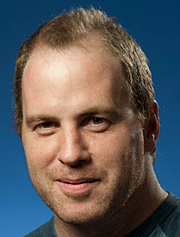- Number 324 |
- November 8, 2010
Fermilab physicist looks for the dark side of the universe

Juan Estrada, Fermilab
Physicist Juan Estrada spends most of his time building and testing imaging sensors for a 570-megapixel camera that scientists will use to search for signs of dark energy. But looking for the energy scientists think makes up 70 percent of the universe wasn’t enough for him.
Estrada figured out a way to use the same technology to search for dark matter, which scientists think accounts for 25 percent of the universe. In doing so, he created the best detector in the world for spotting low-mass dark-matter particles underground, installed at DOE’s Fermi National Accelerator Laboratory.
“Juan is relatively new to the dark-matter field,” said Dan Bauer, deputy head of Fermilab’s Center for Particle Astrophysics. “You’d think it’d be enough of a challenge to work on the Dark Energy Camera. But he somehow had spare time to think of new ideas.”
Estrada started at Fermilab as a student from the University of Rochester working on the DZero particle collider experiment. As a 32-year-old postdoc, he earned a Wilson Fellowship, which gave him up to five years to study what he wanted at the laboratory.
He had worked on cosmology as an undergraduate in Argentina, so he chose to work on the Dark Energy Survey, much to the surprise of his colleagues.
“Nobody on DZero knew that Juan was a closet astrophysicist,” said Tom Diehl, Estrada’s former DZero colleague who now works on the Dark Energy Survey as well.
For the Dark Energy Camera, Estrada builds charge-coupled devices that can capture the light from extremely distant galaxies and supernovae in search of evidence of dark energy. Estrada’s side project, known as the Dark Matter in CCDs (DAMIC) experiment, uses those CCDs in an experimental hall 350 feet underground to search for light emitted by dark-matter collisions.
When Estrada began his dark-matter search, most experiments were searching for dark-matter particles with high mass. Today, his work is gathering attention because results from experiments such as DAMA in Italy and COGENT in Chicago have been consistent with predictions for low-mass dark-matter particles.
Estrada already is working on his next prototype dark-matter detector, which he hopes to install in a deeper underground laboratory. In his spare time, of course.—Kathryn Grim
Submitted by DOE's Fermi National Accelerator Laboratory
